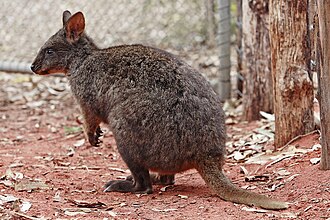AY Honors/Marsupials/Answer Key
The Quokka (Setonix brachyurus), the only member of the genus Setonix, is a small macropod about the size of a large domestic cat. Like other marsupials in the macropod family (such as the kangaroos and wallabies), the Quokka is herbivorous and mainly nocturnal.
Ecology
In the wild, its roaming is restricted to a very small range in the South-West of Western Australia. The Quokka has become rare, but remains a protected species on two islands off the coast of that area, Bald Island, Rottnest Island, Garden Island and rarely Penguin Island. Both islands are free of foxes and cats. On Rottnest Island, it is common and occupies a wide range of habitats, ranging from semi-arid scrub to cultivated gardens.
Description
It weighs 2.5 to 5kg and is 40 to 54 cm long with a 25 to 30 cm tail — which is rather short for a macropod. It has a stocky build, rounded ears, and a short, broad head. Although looking rather like a very small, dumpy kangaroo, it can climb small trees and shrubs. Its coarse fur is a grizzled brown colour, fading to buff underneath. The Quokka recycles a small amount of its waste products.
Behaviour
The Quokka is gregarious and gathers in large groups where food is available: primary items are grasses, sedges, succulents and foliage. The health of some animals has suffered significantly by the ingestion of inappropriate foods, such as bread, given by well meaning visitors to Rottnest Island. Visitors are now asked to refrain from feeding them. It breeds at any time on the mainland, but in late summer on Rottnest. The Quokka only produces a single joey in a year. Restricted availability of the trace element copper appears to be a major limiting factor of the ability of the Quokka to breed on Rottnest.
The Quokka's movements are similar to a kangaroo, using mixture of small and large hops.
Interaction with Humans
The Quokka has no fear of humans and it is common for it to hop up close enough to humans to be petted, particularly on Rottnest Island. It is, however, illegal to handle the animals in any way. A AUD100 fine is a commonly issued penalty for doing so.Template:Fact
Quokkas are occasionally abused or killed in sadistic "sports" called "Quokka Soccer."& In a variant on this barbaric practice, quokkas are occasionally beaten to death with heavy sticks in "quokka hockey."
Status
Although numerous on the small offshore islands, it has a very restricted range and is classified as vulnerable. On the mainland, where it is threatened by introduced predatory species such as foxes, it requires dense ground cover for refuge. This refuge and habitat has been taken away from the Quokka by agricultural development, and this has contributed to the decline of the Quokka as well. Also, human-introduced cats and dogs, as well as dingoes, have contributed to the problem, as has the clearing and burning of the remaining swamplands the Quokka have left.
European discovery
The Quokka was one of the first Australian mammals seen by Europeans. The Dutch mariner Samuel Volckertzoon wrote of sighting "a wild cat" on Rottnest Island in 1658. In 1696 Willem de Vlamingh mistook them for rats and named the island "Rottenest", Dutch for "rat nest".
References
External links
- ARKive - images and movies of the quokka (Setonix brachyurus)
- Rare marsupials kicked to death in quokka soccer
cs:Klokan quokka de:Quokka eo:Kvokao fr:Quokka gl:Quokka hu:Kurtafarkú kenguru nl:Quokka ja:クアッカワラビー属 pl:Kuoka

